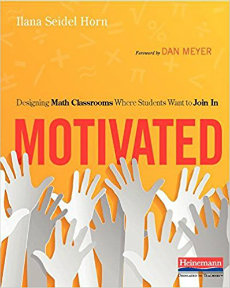Motivating All Kids to Engage in Math Class
Motivated: Designing Math Classrooms Where Students Want to Join In
By Ilana Seidel Horn
(Heinemann, 2017 – Learn more)

Calling on her background as a researcher specializing in authentic math for all students, Ilana Seidel Horn dives right into detailed explanations of why students resist engagement and uses scenarios from a group of exemplar teachers to show how we can turn resistance into attachment.
With just over a hundred pages to read and substantial margins, this text easily turns into a note-filled reference document. It is an easy read in a compact format with a well-rounded perspective on student motivation and their unwillingness to participate in class.

Current and relevant
Horn’s content feels current and relevant. Topics, explanations, strategies and examples fall in line with other recent work that I have read in educational psychology, culturally responsive teaching, mathematical mindsets and the neuroscience of adolescence.
As part of Horn’s framework for student engagement, we must understand the five elements of motivation: belongingness, meaningfulness, competence, accountability and autonomy. Each has its own chapter, but the element that caught my eye, and that I am currently researching, is Belongingness.
The impact of belongingness
Students who have been tracked, segregated, traumatized, discriminated against and/or are emotionally detached from school may feel that they are not welcome in their own classrooms. By fostering belongingness, teachers let students know that they are cared for and appreciated.
Horn cites research that the perception of belonging is directly related to an increase in student achievement and performance. The implication is that influencing a student’s feeling of connectedness to a subject, classroom or school is within a teacher’s control.
The section also offers thought-provoking quotes, research on why feeling welcome in math classes fosters connectedness, and strategies to build connections with students. She does this for each element of motivation, so much so that – if not read in mindful chunks with breaks in between – it can be close to information overload.
A user-friendly book
This book is written in a way that I could easily relate to and understand. At the end of every chapter, reflective questions are included to personalize the information from the section. There are minimal graphics or illustrations, but, when present, they serve to reinforce the textual summary and overall picture of student motivation.
Horn interjects personable humor, and most of her writing reads like a respected colleague or mentor giving advice. Intermittently, references to outside sources are provided which include short, concise descriptions about their significance and implementation.
I would recommend this book to teachers of any subject, but most definitely math, to view classroom engagement from a student perspective and challenge them to change an aspect of their instruction or interaction with students.
Patti Mosko is an avid reader of all things related to education, math and social justice; even better if they are intertwined. Her most recent reading involves Zaretta Hammond who focuses on Culturally Responsive Teaching (http://crtandthebrain.com/about and https://www.tolerance.org/author/zaretta-hammond).
Mosko is currently a George Mason University graduate student finishing up a M.Ed. in Secondary Ed Math. Starting in the fall of 2018 she will be student teaching at a middle school. Several years ago she was a Special Ed teacher who became a stay-at-home mom while her family moved around for the Navy. Her kids are older now, and it’s time to get back to teaching, she says.





























